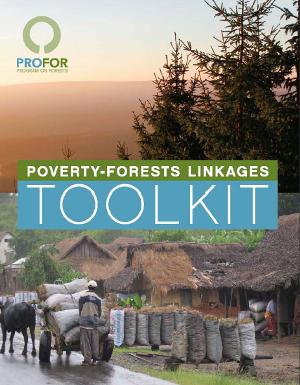
Share
Attachments
Poverty-Forests-NepalCaseStudy_1.pdf
Forests-Poverty-CaseStudyLaoPDR_1.pdf
Download
Authors/Partners
The toolkit had multiple authors including Gill Shepherd and Jill Blockhus. Experts from CIFOR, IUCN, ODI, PROFOR, Winrock International and the World Bank contributed to this work.
Poverty-Forests Linkages Toolkit
CHALLENGE
An estimated 1.2 billion people rely on forests for some part of their livelihoods. However, the importance of forests is often overlooked in national development processes such as poverty reduction strategies due to inadequate evidence documenting how forests sustain the poor.
| Poverty-Forests Linkages Toolkit by PROFOR (Program on Forests) is licensed under a Creative Commons Attribution-Noncommercial 3.0 United States License. Permissions beyond the scope of this license may be obtained by emailing profor@worldbank.org. |
APPROACH
To build better knowledge on this critical relationship, PROFOR developed a “Poverty-Forests Linkages Toolkit” to facilitate relevant data collection and analysis. The Toolkit was created in partnership with CIFOR, IUCN, ODI, and Winrock International, on the basis of case studies in Guinea, India, Indonesia, Lao PDR, Nepal, and Tanzania.
The first draft of the Toolkit was completed in April 2007, and was based on piloting and field testing in three different locations in Indonesian Papua (highlands, lowlands and a mangrove area) and in Tanzania. A consortium of national level organizations led by the International Institute for Economic Development and the Center for International Development and Training carried out further pilots of the Toolkit in four African countries - Cameroon, Ghana, Madagascar and Uganda.
TOOLKIT
What the Poverty-Forest Linkages Toolkit Includes
- A set of rapid appraisal methods to gather information on economic as well as other contributions from forests to households, especially the poor;
- Methods for analyzing field data for the potential role of forests in reducing poverty and vulnerability and policy options for improving the contribution of forests to rural livelihoods;
- Suggestions for how to frame the results so as to be relevant to the planners, government agencies and other institutions and organizations, at both local and national levels;
- An explanation of the PRSP process and identification of the strategies and skills needed for influencing the PRSP process (including potential entry points for forestry); and
- A Field Manual to support training and capacity building for local government forest officials, collection of information to understand forest dependence locally and hands-on application of participatory assessment tools
Field Tools and their Purpose
Tool 1 Wealth RankingPurpose: Understand how poor househoulds use and depend on forest resources | Tool 2 Local Landscape Situation AnalysisPurpose: Understand how villagers use local resources |
Tool 3 Timeline and TrendsPurpose: Record changes in forest resources agriculture, local livelihood strategies and income | Tool 4 Livelihoods AnalysisAim: Determine subsistence reliance on forests and the annual income from forests |
Tool 5 Forests Problem and Solution MatrixPurpose: Identify and rank forest problems and suggest solutions | Tool 6 Trees and Forest Products ImportancePurpose: Rank forest products by importance for cash or subsistence use |
Tool 7 Millennium Development Goals ChartPurpose: to show the contribution of forests to the achievement of the MDGs | Tool 8 Monetary ValuesPurpose: To express the contribution of forestry in monetary terms |
RESULTS
- After piloting was completed in 2008, PROFOR developed a field-compatible version of the toolkit and started providing training in its use. Over 50 World Bank staff and external participants were trained during the World Bank’s annual Sustainable Development Network Forum in March 2009. The toolkit was also disseminated at the XIII World Forestry Congress in October 2009. The training of a dozen National Forest Programme Facility coaches at FAO in February 2010 concluded PROFOR’s direct engagement with the toolkit and transferred product and skills to the NFP Facility for roll out in their country activities.
- IUCN has used the toolkit extensively in its Livelihoods and Landscapes Strategy program, which is active in 23 countries. Using the toolkit, IUCN has extracted new information on the importance of cash and non-cash forest income for forest-dependent people.
- New needs are also arising from the REDD+ process as countries struggle to understand the link between livelihoods and depdendence on forest resources.
For stories and updates on related activities, follow us on twitter and facebook, or subscribe to our mailing list for regular updates.
Author : The toolkit had multiple authors including Gill Shepherd and Jill Blockhus. Experts from CIFOR, IUCN, ODI, PROFOR, Winrock International and the World Bank contributed to this work.
Last Updated : 06-16-2024








